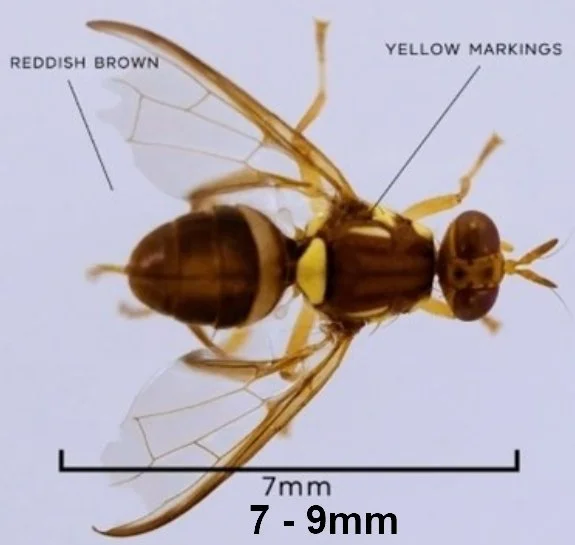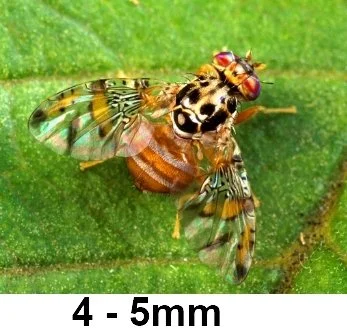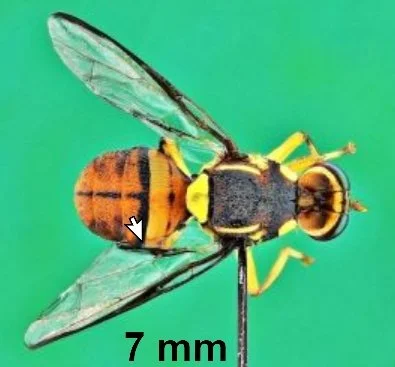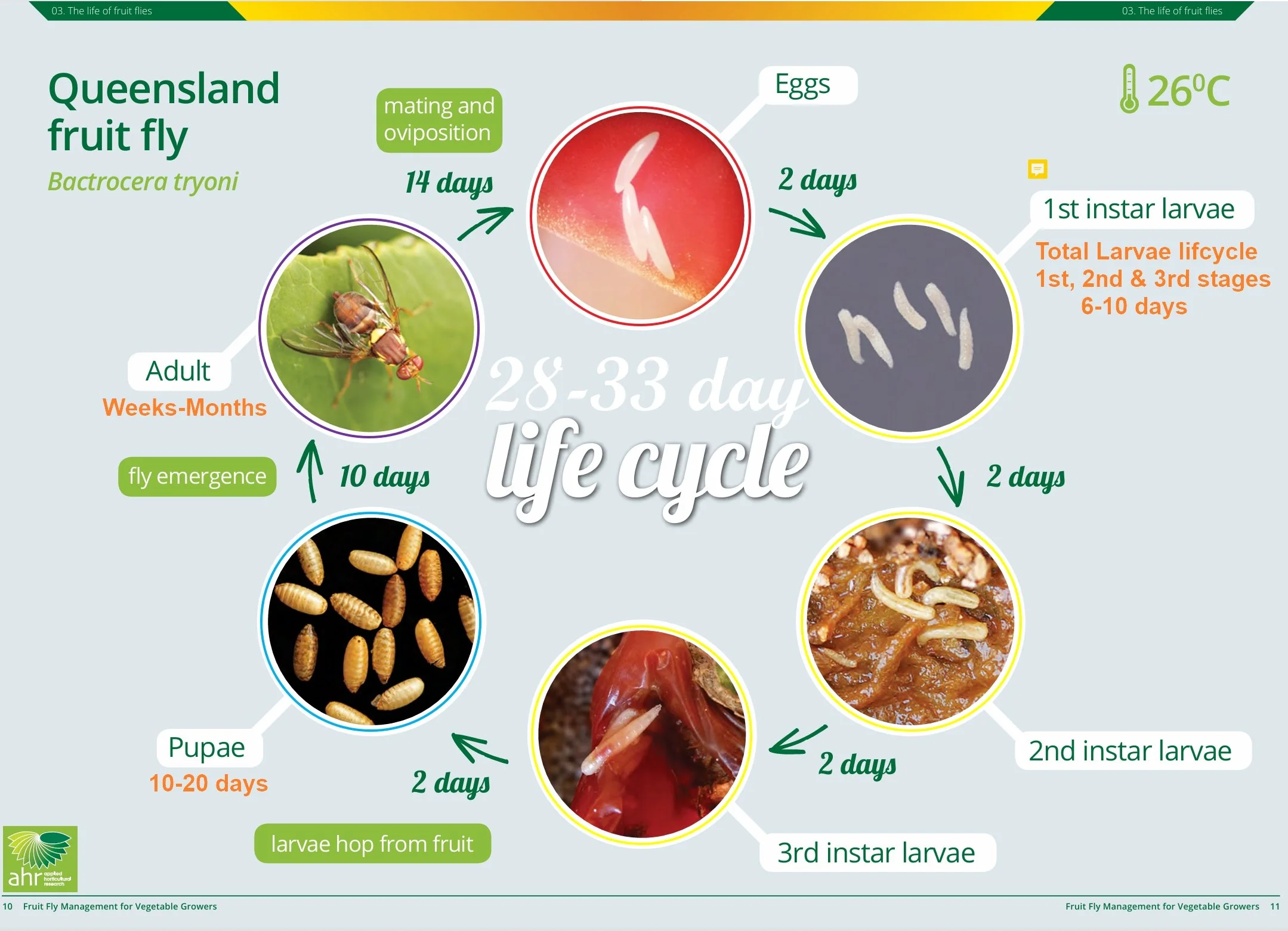
Fruit Fly
Fruit flies (family Tephritidae) are among the world’s most destructive horticultural pests; larvae feed inside fruit and vegetables, making produce unmarketable. They reproduce rapidly, and many species attack hundreds of host crops, fruits and vegetables.
Fruit Fly Global Presence
This page is primarily focused on the Queensland Fruit Fly (QFF), which is native to Queensland but has spread to the Northern Territory, Queensland, New South Wales and Victoria and causing major market and production impacts
The two major pest species currently of national concern are:
Queensland fruit fly (Bactrocera tryoni), is native to Queensland; however is endemic and established in parts of eastern Australia.
Mediterranean fruit fly (Ceratitis capitata), an introduced species largely confined to south‑west Western Australia, although eradication efforts have succeeded 10+ times.
Major invasive species and general ranges
Queensland fruit fly (Bactrocera tryoni) — native to eastern Australia but a major regional pest with quarantine attention to prevent wider international spread.
Mediterranean fruit fly (Ceratitis capitata) — native to sub‑Saharan Africa; now established across southern Europe, parts of Africa, the Middle East, South and Central America, parts of North America, and some Pacific islands.
Mediterranean fruit fly (Ceratitis capitata), or medfly, is a significant horticultural pest that is established in parts of Western Australia.
There have been detections of medfly in South Australia however, outbreaks have been eradicated and South Australia undertakes activities to ensure medfly does not become established.
Oriental fruit fly (Bactrocera dorsalis) — native to tropical Asia; now widespread across Asia and the Pacific and recorded as invasive in Africa and parts of Oceania. Oriental fruit fly is not present in Australia but is established in many nations in Asia and Oceania. Thus, the risk of incursions into Australia are high and would result in significant economic impact. Eradication of the 1995 Oriental fruit fly incursion in Cairns cost $33 million and took 4 years, a small cost in comparison of the damage if it hadn’t been eradicated.
Peach fruit fly (Bactrocera zonata) — native to South Asia; expanding across Asia and Africa with climatic-suitability projecting further spread under climate change.
History of spread
Early distribution and origin — QFF is native to eastern Australia, historically centred on tropical and subtropical Queensland and nearby coastal zones.
20th century inland and southward expansion — throughout the 1900s QFF expanded from its Queensland strongholds into adjacent parts of New South Wales and into southern temperate regions during favourable years, driven by the movement of infested produce and expanding suitable habitat.
Establishment in Victoria and intermittent incursions elsewhere — by late 20th and early 21st centuries, QFF had seasonal or established populations in parts of Victoria and occasional detections in South Australia and the Northern Territory; climatic suitability and local outbreak events have allowed persistence in new pockets and seasonal incursions into previously low‑risk areas
Recent range shifts and modelling evidence — contemporary surveillance and climate‑vulnerability modelling show increasing climate suitability further south and inland in Australia, raising the risk of more frequent outbreaks and longer activity seasons in regions that were previously marginal for QFF.
Research and management responses — national research programs and state biosecurity agencies have focused on improved phenology models, area‑wide management, surveillance and export phytosanitary protocols to manage spread and reduce market impacts.
Economic impact
The economic impact of Queensland Fruit Fly (QFF) causes direct production losses and reduced marketability that amount to millions of dollars each year for Australian growers and supply chains, where outbreaks increase surveillance, control and compliance costs for governments and producer groups, and can threaten export market access with additional economic consequences:
Crop losses from fruit rendered unsaleable.
On‑farm control costs (baiting, insecticides, monitoring).
Area‑wide management and eradication expenditures (surveillance, quarantine, SIT trials).
Market access and compliance costs when outbreaks constrain exports or require extra phytosanitary measures
Behaviour
Life cycle and development: Adults emerge from pupae in soil and live as flying, feeding insects; development passes egg → larva (maggot) → pupa → adult, with the soil pupal stage commonly lasting about 10 days under warm conditions and lengthening in cooler weather.
Seasonal activity and phenology: QFF activity is seasonal: adults become active in late winter–spring as temperatures rise, populations build through late spring and summer when hosts are abundant, activity declines in autumn, and many flies overwinter as adults in sheltered sites or as pupae in soil or fallen fruit during mild winters.
Reproduction and fecundity: Females sting fruit to lay eggs and can lay large numbers of eggs (dozens to about 100 per day under favourable conditions), producing successive generations that cause rapid population increases when hosts and temperatures permit
Dispersal and movement: Short‑ to moderate‑distance dispersal occurs by adult flight between host trees, orchards and gardens; long‑distance spread is driven by human movement of infested fruit and produce, enabling jumps beyond natural flight range and seeding new outbreaks.
Host use and feeding behavior: Adults feed on sugars from ripening fruit, nectar and plant exudates, while larvae feed inside fruit, causing internal damage that often leaves external fruit appearance deceptively normal; QFF attacks a wide range of fruit and fruiting vegetables and shifts hosts as different crops come into season.
Behavioural traits relevant to control: QFF are attracted to protein and cue‑lure baits used in monitoring and suppression; females respond to protein baits for feeding and oviposition cues, making baiting, trapping and exclusion (netting, fruit bagging) effective parts of integrated control when applied consistently and early in the season.
Diet
Their diet includes 100+ fruits and many vegetables. Home gardeners list
Blackberry infestations, abandoned/unmanaged fruit trees and movement of infected produce are a high-risk breeding cycle source
Queensland fruit fly adults feed on sugary resources for energy and on protein sources to mature eggs, while larvae feed inside host fruit on the fruit pulp and juices.
Sugars and carbohydrates: adults feed on nectar, honeydew, sap and surface sugars on ripening fruit to fuel flight and daily activity.
Protein and nitrogen: adults, especially females, seek protein sources (decaying matter, bacterial films on fruit and leaves, protein baits) to develop eggs and increase fecundity.
Adults will take small droplets of protein or sugar from foliage and trunks where baits are applied, making bait sprays effective because flies forage on leaves and tree trunks.
Reproduction Lifecycle
A Queensland fruit fly (QFF) life cycle takes about 4 weeks in favourable conditions (warm temperatures and high rainfall and humidity), but longer in cool, dry weather (Figure 2). The adult population reduces in winter, with some inactive adults surviving by sheltering (over-wintering) in protected areas.
Adult female flies lay eggs in batches of up to 12 by stinging ripening fruit. Eggs hatch in 2–3 days
Larvae begin feeding on the fruit. The larvae (maggots) are fully grown in about 10 days and emerge by ‘flicking’ from the fruit to pupate in the soil.
Pupation lasts about 10–20 days
QFF is a very small fly approx. 7-9mm. The adult fly emerging to feed on water, protein and sugars. Female flies mate once, while male flies can mate many times. If a female has fed on protein, she begins laying eggs 7–20 days after emerging from the soil. A single QFF can lay up to 2,000 larvae in her lifecycle. Adult flies can live from weeks in the summer, up to months over winter.
Management
Once infected, management is intensive to halt the spread to other areas:
Alert others in the community
Identify source & the spread – remove & treat, must heat or freeze treat to kill to lifecycle. The infected produce cannot be thrown into a bin or compost without treatment, as this doesn’t kill the eggs/larvae, and the lifecycle will just continue and the problem will spread.
Once it’s been identified, generally the best approach for home gardens is to strip all the fruit/veg and boil, microwave or freeze to kill the eggs/larvae and effectively remove further opportunities for the fly to continue to infect other produce.
Notify your neighbours, Landcare group, local social media group (eg: Steels Creek FaceBook) to allow everyone to inspect, set up traps and take appropriate action if infected.
We all need to be aware and active in eradicating the fly and outbreaks. Ignoring the issue or not notifying of the infection will only make the situation worse. One of the key areas of risk is unmaintained fruit trees and blackberry infestations
Increase monitoring intensity, continue trapping
Bait, bait, bait :
You only need one pheromone trap in a backyard, but you only catch the males and this limits breeding.
Protein traps attract both sexes, but you have to change the bait every week and you need lots of them.
Exclusion works well, but it is quite a bit of work and it's a little unsightly, so you'll need to see what works best for your garden.
Net crops. Ensure your trees are manageable/accessible in terms of height so all fruit can be harvested and/or the tree can be netted for QFF. Generally, for most people, this means maintaining trees that are less than 2 to 2.5m in height. In locations such as Mildura, netting of trees and vegetable patches is an annual seasonal must-do due to the prevalence of QFF.
Improve hygiene/sanitation
Cull risks (more drastically than the prevention stage) - unmanaged or difficult to manage trees/crops
Consider cover sprays – protocols, IPM, economic threshold
Links to further information
Click here to send a request to add a new link
Videos - Control Methods
Videos - General Info
General Information
Government Information
Community Management








